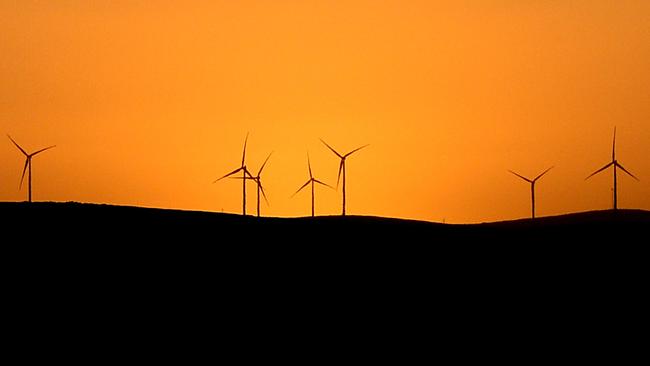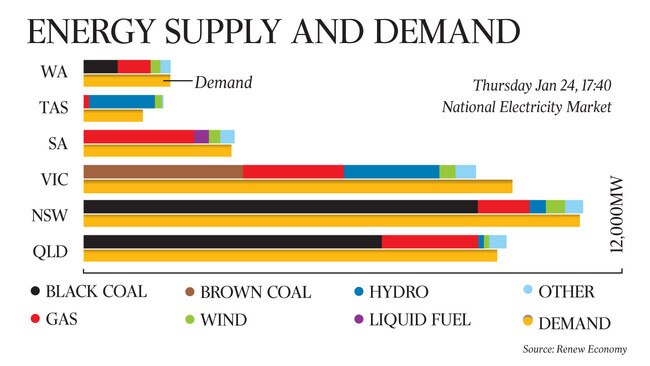Heat stress: power crisis hits home
The electricity system operator taps emergency powers as failed generators stretch the grid and thousands are plunged into darkness.

Australia’s electricity market was plunged into crisis when a searing heatwave in South Australia and Victoria forced the system operator to tap its emergency powers to avoid blackouts as failed generators stretched the grid to breaking point.
The market operator asked customers in the two states to cut their power usage, under a process called “load shedding”, to ease pressure on the grid.
Despite the emergency measures being used for the first time in a year, 20,000 households in Adelaide were blacked out last night after power infrastructure buckled under the state’s severe heat. Power was knocked out from 90 electricity transformers on streets after the electric fuses failed due to the record temperatures and would not cool, SA Power Networks said.
Consumers were also asked to avoid using dishwashers, washing machines and pool pumps during peak times and lower their blinds before going to work to cool houses and lower demand.
Spot power prices hit the maximum of $14,500 a megawatt hour in South Australia yesterday, while in Victoria they reached $14,444/MWh, compared with average prices of $100/MWh.
Australian Energy Market Operator data shows prices in both states are forecast to remain at $14,500/MWh until tomorrow.

South Australia’s controversial diesel generators, introduced by former premier Jay Weatherill as a response to the 2016 statewide blackout, were also called on for the first time, initially to send generation to Victoria, as the grid struggled to cope following the loss of more than 1500MW of baseload coal and gas generation from some of the nation’s largest suppliers this week.
Under the emergency measures, a raft of big energy users cut consumption and previously unneeded sources of power swung into action. The emergency response unit was used for the first time since its activation more than a year ago in South Australia and for just the fifth time in the past two decades, underlining the precarious balancing act for the government as it seeks to improve stability and provide lower prices.
In South Australia, which typically relies on renewables for half its power needs, wind supplied less than 4 per cent of the state’s electricity yesterday. Gas generators did the heavy lifting, accounting for 82 per cent of generation with diesel also chipping in.
Victoria was in a similar position, with wind supplying 3.8 per cent of the state’s requirements as brown coal, gas and hydro were deployed to meet rising demand.
AEMO said it tapped the Reliability and Emergency Reserve Trader mechanism yesterday afternoon to maintain the state’s power systems “in a secure and reliable operating state”.
Big energy users such as Alcoa’s Portland aluminium smelter in Victoria and the Whyalla steelworks in South Australia are paid to provide emergency relief to steady the fragile power network. The operator can call on 940MW of supply reserves through the safety net but using the last-ditch method comes at a considerable cost, with on-standby suppliers paid at hugely inflated rates under the demand response scheme.
AEMO said Alcoa was required to reduce production from about 7.10pm (AEDT) to 8.50pm.
Adelaide hit 46.6C yesterday afternoon, breaking the city’s 80-year-old record of 46.1C, while Melbourne topped 40C, ratcheting up demand on the power system. Whyalla and Wudinna reached 48C yesterday and Tarcoola hit 49C. Towns in Victoria’s northwest are headed for 46C today.
The decision to invoke load shedding marked an abrupt turnaround after AEMO chief executive Audrey Zibelman had earlier yesterday insisted the move would not be necessary.
Ms Zibelman had said load-shedding would be necessary if the reserves were not sufficient to get through the peak period, but she did not expect this to eventuate. “We’re working very closely, for example, with the smelter, as well as AGL, and so we would expect that they’re also going to go offline during the peak period if we need them to go,” she said.
“At this point, we’re in a position where we anticipate we have enough resources to get us through the peak.”
AEMO was forced into the emergency measures hours later as a result of a shortfall of available generation reserves.
Federal Energy Minister Angus Taylor said yesterday’s use of the emergency measures highlighted the need for investment in reliable generation. Resources Minister Matt Canavan said: “We have an ageing thermal power fleet in Southern Australia at the same time as very tight market conditions across the grid.”
Ms Zibelman said AEMO did not expect blackouts today, with a cool change expected to cross South Australia, reaching Melbourne about 3pm.
Earlier yesterday, the grid suffered a setback with the failure of a unit at AGL’s Liddell coal-fired power plant in NSW, making it the fourth major generator unable to supply full capacity to electricity users.
In addition to Liddell’s outage, a 560MW unit from AGL’s Loy Yang A coal station in Victoria’s Latrobe Valley was knocked out of action on Tuesday because of a tube leak.
Repairs are likely to take about three days.
At the nearby Yallourn coal-fired power station, a 370MW unit was also out of action because of regular maintenance, cutting a quarter of the facility’s load. Owner EnergyAustralia said the works on the facility could not wait and it expected the unit to be back up and running next week.
The energy operator’s 435MW Tallawarra gas-fired unit in NSW also dropped out of service on January 17 from a rupture in a cooling pipe. The company is yet to outline when it will resume operations.


To join the conversation, please log in. Don't have an account? Register
Join the conversation, you are commenting as Logout